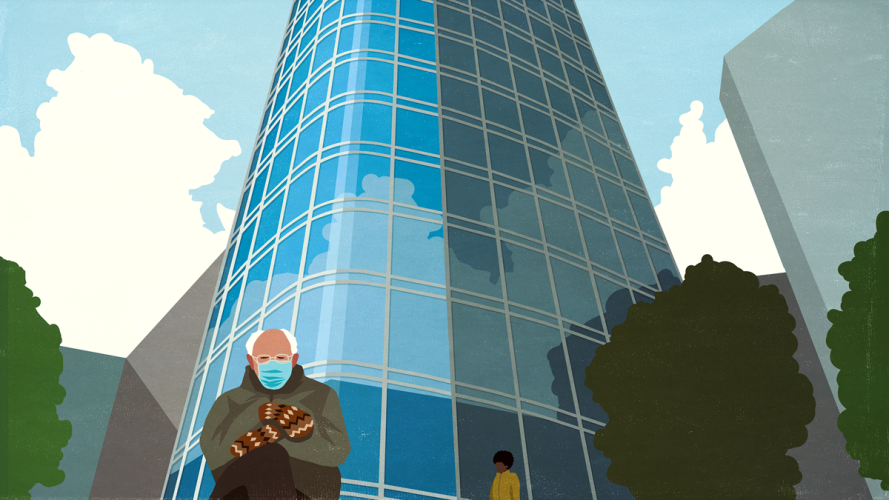How I Built an App That Went Viral Overnight



The surprising “Bernie Sits” app development journey that scaled to a worldwide phenomenon.

Nick Sawhney
When Trailblazer Nick Sawhney created an app with Heroku, he never expected that it would go viral in a matter of hours. This is Nick’s first-hand account of how Bernie Sits began, and his journey with Salesforce in making his ideas come to life.
How I got started with app development
I began tinkering with apps in college. The first app I built was with a friend at a hackathon. We made an interactive map showing attitudes toward trending political topics, based on data from Twitter. Since then, I discovered a passion for the intersection of social media and computer sciences.
The first time I built an app with Heroku was for a joke with friends. We were discussing some pretty serious topics in a group chat: the pandemic, politics, and our own personal struggles. I wanted to create a bot that would help lighten the mood.
I wanted to put the app online quickly, so the first place I looked was (of course) Google. Heroku came up as an ideal option — it’s a cloud platform that anyone can use to build and scale apps quickly.
In a few hours our “inside joke bot” was up and running. It would respond to keywords with memes, funny images, or even a little back-and-forth banter. I noticed that the simpler I made the bot’s features, the more my friends interacted with it. My humorous software actually began to feel human. I was able to make immediate improvements based on my friends’ feedback and saw firsthand how easy it was to build apps using Heroku.
Why I picked Heroku: speed, integrations, and ease of use
When I made Bernie Sits, I didn’t imagine it would go viral. I just wanted to make a fun app and put it online as quickly as possible. I knew from my previous chatbot experience that Heroku lets me update my app in real time if I run into any snags. However, I didn’t expect to scale from just a few dozen memes between friends to 9.8 million people overnight.
Turn your ideas into reality using Heroku
See why companies have built more than 9 million apps on Heroku.



Building my viral app took only an hour
I started with a public image of Bernie Sanders that my friend cropped. I knew Heroku was really easy to integrate with other apps, so I chose Google Maps because it would let me put Bernie anywhere in the world. I used a simple template and some basic code — and before I knew it, Bernie Sits was live!
The app grew in popularity fast. I soon realized it was working on my computer but not publicly on the internet, and it was at that point that I sent out a desperate tweet asking for help. I thought for sure that would be the end of my story, but Salesforce Director of Technical Architecture, Dan Mehlman, happened to see it. Within 30 minutes, I was on a call with Senior Solutions Engineer Jack Ziesing, who had sent me a meeting invite link and waited patiently for me just in case I showed up to the call.
I didn’t want my first meeting with a real engineer at a real company to be embarrassing. But it turned out that the people from Heroku made an almost bigger impact on me than the actual capabilities of the product.

Scaling the app quickly and easily even after it went viral
Since I’d never taken a web development class, I knew I had no chance of scaling the website without Jack’s help. As soon as we started speaking, I felt more confident about what was happening. People liked something I made — and now I had visceral proof of that from a really cool engineer. Jack jumped on the Heroku metrics page with me and started explaining why the site was slowing down, and helped walk me through scaling to protect the site.
The fact that I was working with a real person distracted me from all the Twitter notifications, and allowed me to solve the problem I overlooked when I was stuck and inundated by the whirlwind of tweets. Turns out, it was just a simple API issue, one that Jack helped me solve in about 10 minutes. By the time that change was pushed, Jack not only fixed the scaling issues but also had succinctly explained to me how everything worked to the point where I felt comfortable doing some basic scaling for the rest of the night. Once it all started working, we sat together for a moment in silence and watched thousands of people use the site at once.
Putting the “customer” back in customer success
This experience opened my eyes to the power of the engineering community, but even more importantly to the power of a single person caring enough about my low-key meme project to connect as strangers across 3,000 miles. Salesforce says customer success is one of its core values, and this became very real to me when a Heroku engineer partnered with me in his off-hours to save my dream.
Nick Sawhney shares his experiences using Heroku when an afternoon project explodes into a worldwide phenomenon



Throughout the weekend and since, Jack, Dan, and so many other talented individuals from Heroku and Salesforce have been in contact with me — encouraging me, uplifting me, giving me sincere and sound advice. I didn’t owe them anything; I didn’t even know they existed before that Wednesday. But they believed in their product and they believed in me.
The confidence in myself and in the engineering community that I was blessed with from this little half-hour moment was the premiere takeaway of this experience.
It gave me the personal confidence and professional support network to turn my little joke into a cultural phenomenon. The tech was cool, and the people were even cooler. I’m so grateful — and know I will only keep building from here.
Create your own low-code apps
Learn how to build impactful apps that scale businesses in no time.


























